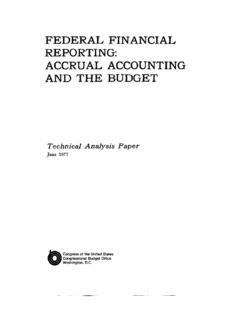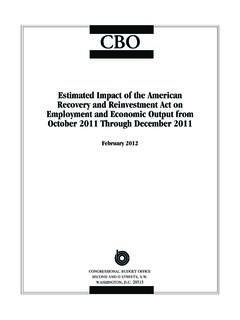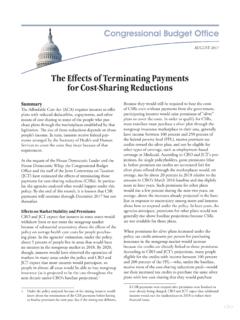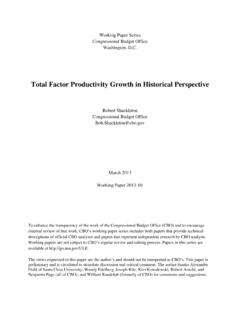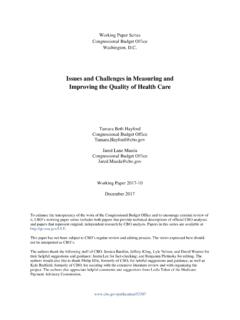Transcription of An Assessment of CES and Cobbs-Douglas Production Functions
1 An Assessment of CES and Cobb-Douglas ProductionFunctions1 Eric MillerE-mail: Budget OfficeJune 20082008-051 Working papers in this series are preliminary and are circulated to stimulate discussion andcritical comment. These papers are not subject to CBO s formal review and editing analysis and conclusions expressed in them are those of the authors and should not beinterpreted as those of the Congressional Budget Office. References in publications shouldbe cleared with the author. Papers in this series can be obtained at (selectPublications and then Working Papers). I would like to thank Bob Arnold, Juan Contreras,Bob Dennis, Matthew Goldberg, Angelo Mascaro, Delciana Winders, and Thomas Woodwardfor helpful paper surveys the empirical and theoretical literature on macroeconomic productionfunctions and assesses whether the constant elasticity of substitution (CES) or the Cobb-Douglas specification is more appropriate for use in the CBO s macroeconomic Cobb-Douglas s major strengths are its ease of use and its seemingly good empiricalfit across many data sets.
2 Unfortunately, the Cobb-Douglas still fits the data well incases where some of its fundamental assumptions are violated. This suggests that manyempirical tests of the Cobb-Douglas are picking up a statistical artifact rather than anunderlying Production function. The CES has less restrictive assumptions about theinteraction of capital and labor in Production . However, econometric estimates of itselasticity parameter have produced inconsistent results. For the purpose of forecastingunder current policies, there may not be a strong reason to prefer one form over theother; but for analysis of policies affecting factor returns, such as taxes on capital andlabor income, the Cobb-Douglas specification may be too takes something more than the usual willing suspension of disbelief to talk seriously ofthe aggregate Production function.
3 (Robert Solow, 1957, p. 1)1. IntroductionA macroeconomic Production function is a mathematical expression that describes a sys-tematic relationship between inputs and output in an economy, and the Cobb-Douglasand constant elasticity of substitution (CES) are two Functions that have been used ex-tensively. These Functions play an important role in the economic forecasts and policyanalysis of the CBO and others. For example, the CBO uses Production Functions toforecast potential output and the medium-term outlook for income shares. Addition-ally, several of the models that the CBO uses to analyze policy changes, such as themultisector Aiyagari (1994) model and the overlapping generations model, assume thataggregate output in the economy can be described by a Production all of these cases the CBO assumes that the economy s underlying Production tech-nology takes the Cobb-Douglas form.
4 This specification has long been popular amongeconomists because it is easy to work with and can explain the stylized fact that in-come shares in the United States have been roughly constant during the postwar have also been somewhat well disposed toward Cobb-Douglas because itgives simple closed-form solutions to many economic problems. However, empirical andtheoretical work has often questioned the validity of the Cobb-Douglas as a model ofthe economy. Some economists believe that the more general CES may be a more1 Although Cobb-Douglas does restrict the elasticity of substitution between the demand for laborand capital in Production , it does not address labor-supply issues such as the substitution between laborand leisure, or the trade off between consumption spending and saving to increase the capital are issues which the CBO has examined extensively.
5 For a further discussion see CBO (2008).1appropriate paper will examine the major strengths and weaknesses of these two functionalforms and suggest which form is better able to forecast income shares under given poli-cies. This is important for budget estimation because one cannot predict the future pathof the federal budget without first predicting how national income will be apportionedbetween capital and labor. These two sources of income are subject to different taxtreatments and as a result their relative sizes are an important determinant of futuretax revenues. While the focus of this paper is forecasting, many of the issues it raisesare pertinent to policy analysis as paper begins with a review of some basic concepts in Production theory.
6 Readerswith a solid understanding in this area should skip ahead to section 3, which discussessome general theoretical problems with the use of aggregate Production Functions . Sec-tion 4 reviews the empirical performance of the CES and Cobb-Douglas. The paperconcludes with a recommendation to continue using the Cobb-Douglas in spite of the-oretical concerns because it appears that additional costs and parameter uncertaintiesfrom the use of the CES are not outweighed by its Production FunctionsA Production function is a heuristic device that describes the maximum output that canbe produced from different combinations of inputs using a given technology.
7 This canbe expressed mathematically as a mappingf:RN+ R+such thatY=f(X), whereXis a vector of factor inputs (X1, X1, , Xn) andf(X) is the maximum output that canbe produced for a given set of inputsXi R+.2 This formulation is quite general and2It is possible to have a Production function that produces a vector of outputs, but in order tosimplify the analysis this paper limits its scope to Functions that map a vector of inputs to a be applied at both microeconomic ( , individual firm) and macroeconomic ( ,overall economy) levels. While Production Functions were originally designed with theindividual firm in mind, macroeconomists came to realize that this methodology providesa useful tool for estimating certain parameters that cannot be directly measured fromnational accounts data.
8 The most important of these is the elasticity of substitutionbetween capital and of substitution in Production is a measure of how easy it is to shift betweenfactor inputs, typically labor and capital. This measure is defined as the percentagechange in factor proportions resulting from a one-unit change in the marginal rate oftechnical substitution (MRTS). MRTS is the rate at which labor can be substituted forcapital while holding output constant along an isoquant; that is, it is the slope of theisoquant at a given point. Thus, for a two-input Production function,Y=f(K, L), theelasticity of substitution between capital and labor is given by =% (K/L)% M RT S=[d(K/L)dM RT S] [M RT S(K/L)]= ln(K/L) M RT S(1)where can be thought of as an index that measures the rate at which diminishingmarginal returns set in as one factor is increased relative to the other (Nelson 1964).
9 When is low, changes in the MRTS lead to small changes in factor proportions. Inthe extreme case of fixed proportions or Leontief (1941) technology,Y=min(aK, bL)where a, b >0(2)the resulting isoquants are L-shaped and = 0. This implies that changes in the MRTS will not cause any changes in factor proportions, so output is maximized by producingin fixed ratios. The other extreme is linear Production technology,3Y=aK+bL(3)where capital and labor are perfect substitutes. Here the MRTS is constant so theisoquants are straight lines and = . The Cobb-Douglas form,Y=AK L1 (4)lies between these two extremes, with = 1. This specification creates isoquants thatare gently convex and easy to work 1.
10 Isoquant Maps for Production Functions with Different Elasticities4 Elasticities of substitution provide a powerful tool for answering analytical questionsabout the distribution of national income between capital and labor. If we assume thatmarkets are competitive, then factors will be paid their marginal product. Hence, thewage rate will equal the marginal contribution from an additional worker and the returnon capital will match the contribution in output that a marginal increment of capitalprovides. The elasticity of substitution can now be written as =% (K/L)% (w/r)= ln(K/L) ln(w/r)(5)wherewis the wage rate andris the rental rate of capital.

